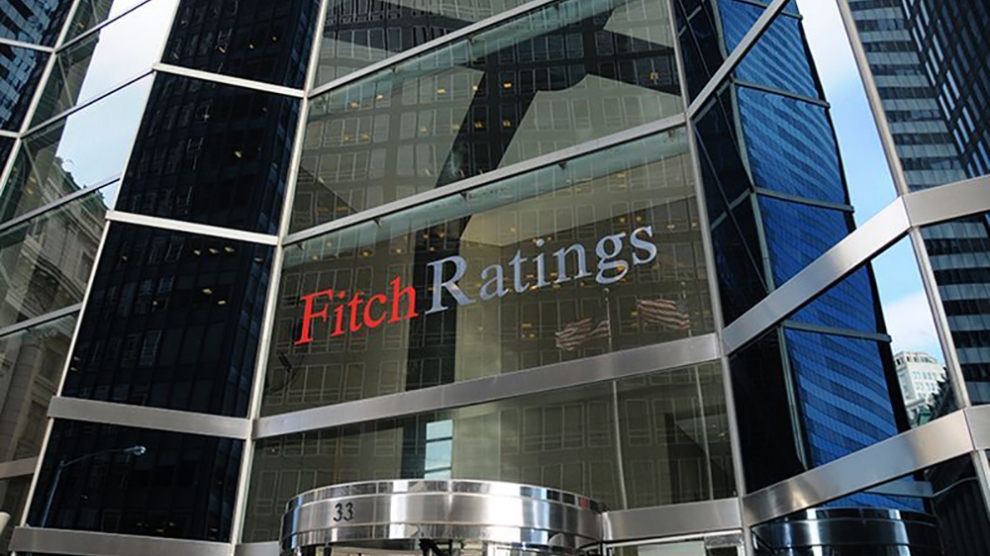NEW YORK, NEW YORK (By Fitch, 2.Oct.2025, Words: 1,600) — Fitch Ratings has removed Petroleos Mexicanos‘ (PEMEX) Long-Term Local and Foreign Currency Issuer Default Ratings (IDRs) from Rating Watch Positive (RWP) and upgraded them to ‘BB+’ from ‘BB’. The Rating Outlook is Stable. Fitch has also removed PEMEX’s outstanding senior unsecured notes from RWP and upgraded the rating to ‘BB+’ from ‘BB’.
RELATED: Pemex says 2 transactions reduce foreign currency obligations
The upgrade follows Pemex’s successful execution of a $9.9bn tender offer across eight security series funded with cash proceeds from the Mexican government. The transaction indicates increased linkage between PEMEX and the sovereign, resulting in an increase in the company’s Oversight, Linkage and Support (OLS) assessment. Fitch now rates PEMEX only one level below Mexico’s sovereign rating instead of two levels below it, resulting in the upgrade.
KEY RATING DRIVERS
Improved GRE Linkage Score: Mexico has taken legislative actions that allow PEMEX to share a debt ceiling with the Secretariat of Finance. These changes are intended to materially address the company’s leverage and funding cost. The $9.9bn tender for eight series of PEMEX securities was executed as planned and financed with United Mexican States cash. This operationalizes the legislative intent and provides tangible evidence of stronger government direction, support and control over PEMEX’s financial policy.
Based on this development, Fitch revised the Oversight and Decision-Making subfactor to ‘Very Strong’ from ‘Strong’ per our Government-Related Entity (GRE) criteria. This caused a five-point increase in PEMEX’s OLS to 35 from 30. This score led to a change in Fitch’s approach to notching PEMEX’s IDR just one level below the sovereign rather than two and resulted in an upgrade of the IDR to ‘BB+’.
RELATED: Pemex completes repair of Jiliapa I pipeline in Tihuatlán, Veracruz
Financial Profile Persistently Weak: PEMEX’s Standalone Credit Profile (SCP) is ‘ccc’, reflecting persistent negative FFO, EBITDA compression due to lower crude prices and production, tight liquidity, and unrelenting losses in the downstream business. On 30 Jun. 2025, PEMEX had $98.8bn in debt and interest expenses of $2bn, over half of the quarter’s EBITDA. Expected leverage in 2025 decreased by one turn after the tender, and leverage through the rating horizon remains unchanged, exceeding 15x.
Deteriorating Operational Performance: Fitch believes the multiyear underinvestment in both the upstream and downstream assets will continue eroding operational and financial performance. Multiple incidents at critical assets signal a lack of maintenance capex. The new administration has been vocal regarding a cap to upstream production and has intensified efforts in the downstream, which will continue to pressure liquidity unless ongoing government support is provided to address capex and debt service. The production and development of new fields has declined in the last few years, making exploration and production (E&P) capex a top risk.
RELATED: Sheinbaum’s 2026 economic package addresses welfare programs, Pemex bailout
ESG – GHG Emissions & Air Quality: PEMEX’s history with GHG emissions poses an ESG risk. Multiple fires at critical assets will likely affect local communities and the environment. Fitch believes operational management and the lack of maintenance capex for core assets and infrastructure will further challenge PEMEX’s financial profile. This was a key consideration in the ‘B+’ rating, as PEMEX’s ESG track record can further impair its ability to raise capital.
ESG – Hazardous Materials Management: The last 10 years of underinvestment has contributed to the deterioration of transportation infrastructure. Certain pipelines have had leaks, releasing contaminating products near nature and population. This issue poses an ESG risk as environmental remediation costs and related litigation could further pressure the company’s liquidity position.
ESG – Employee Wellbeing: Employee Wellbeing is also an ESG risk in assessing PEMEX’s credit profile. Several incidents stemming from underinvestment in critical assets have caused injuries and fatalities of employees and contractors. Many of these have also had damaging environmental impacts, likely affecting the company financially and reputationally.
ESG – Management Strategy: PEMEX’s management track record and its financial distress could complicate its ability to execute on its strategy.
RELATED: Pemex eyes work at Deer Park refinery in Houston
PEER ANALYSIS
PEMEX’s link to the sovereign is weaker compared to Petroleo Brasileiro S.A. (Petrobras) (BB/Stable), Ecopetrol S.A. (BB+/Negative), and Empresa Nacional del Petroleo (ENAP) (A-/Stable), which benefit from stronger government support and increased oversight.
RELATED: Second package of secondary laws sent to the Mexican Senate
However, PEMEX compares favorably to Petroleos del Peru – Petroperu S.A. (CCC+) as Peru’s government only meets Petroperu’s immediate needs without improving its capital structure. Petroperu’s market share drop to 25% from 45% caused minimal disruptions due to alternative fuel imports. Fitch believes regional governments, except for Mexico and Peru, have taken steps to ensure their national oil and gas companies’ SCPs remain viable long term.
Fitch views PEMEX’s SCP as commensurate with the ‘ccc’ level, which is 10 notches below Petrobras’s ‘bbb’ SCP and nine notches below Ecopetrol’s ‘bbb-‘ SCP. The differences are primarily due to PEMEX’s weaker capital structure and persisting cash burn. PEMEX’s SCP reflects the company’s historically large transfers to Mexico’s federal government, weakening operations, and a large and increasing financial debt balance when compared with 1P reserves and elevated EBITDA-adjusted leverage. Comparatively, Ecopetrol and Petrobras significantly strengthened their capital structures and maintained stable operating profiles.
RELATED: Pemex personnel respond to leak at Nuevo Teapa Poza Rica-Madero pipeline
KEY ASSUMPTIONS
–Average West Texas Intermediate crude prices of $65bbl in 2025, $60bbl in 2026, and $57bbl for the midcycle;
–Henry Hub prices of $3.6/mcf in 2025, $3.5/mcf in 2026 and $3.0/mcf thereafter;
–Oil production stays flat at 1.75 MMboed;
–Annual capex average of $12bn;
–Government take to average 60% of EBITDA per annum;
–Short-term debt and debt maturities are refinanced at 8%;
–PEMEX will receive necessary support from the government to ensure adequate liquidity and debt service payments;
–Refined product volumes growth moves aligned with Fitch’s real GDP growth forecasts of 0.05% in 2025 and 0.7% in 2026 and thereafter;
— P-Cap transaction addresses $5bn of 2025 bank debt and $6bn of 2026 bank debt;
— Government support of $6.7bn in 2025 and $13.5bn in 2026.
RATING SENSITIVITIES
Factors That Could, Individually or Collectively, Lead to Negative Rating Action/Downgrade
–A downgrade of Mexico’s sovereign rating;
–Weakened ability and/or willingness of the government to meaningfully support PEMEX;
— An inability to successfully manage supplier liability.
Factors That Could, Individually or Collectively, Lead to Positive Rating Action/Upgrade
–Materialization of further support from the government;
–An upgrade of Mexico’s sovereign rating;
–An irrevocable guarantee from Mexico’s government to sustainably cover more than 75% of PEMEX’s debt.
LIQUIDITY AND DEBT STRUCTURE
PEMEX’s liquidity position remains weak because of negative FCF, which resulted in a relatively low cash position and reduced availability of its lines of credit. The company reported total cash and equivalents of MXN96.4bn as of Jun. 2025 and reported MXN1.9tn of total debt with MXN529bn in short-term debt. After the P-cap transaction, as of the end of August PEMEX has repaid $7.8bn of its bank debt, including $4.6bn of its revolving credit lines.
ESG CONSIDERATIONS
PEMEX has an ESG Relevance Score of ‘5’ for Waste & Hazardous Materials Management; Ecological Impacts due to at least 10 years of underinvestment that has contributed to the deterioration of transportation infrastructure. Certain pipelines have had leaks, releasing contaminating products near nature and population. This issue poses an ESG concern as environmental remediation costs and related litigation could further pressure the company’s liquidity position, which has a negative impact on the credit profile, and is highly relevant to the rating, resulting in an implicitly lower rating.
PEMEX has an ESG Relevance Score of ‘5’ for Management Strategy due to PEMEX’s management track record and its financial distress which could complicate its ability to execute on its strategy, and has a negative impact on the credit profile, and is highly relevant to the rating, resulting in an implicitly lower rating .
PEMEX has an ESG Relevance Score of ‘5’ for GHG Emissions & Air Quality due to PEMEX’s history with GHG emissions and multiple fires at critical assets that affect local communities and the environment. Fitch believes operational management and the lack of maintenance capex for core assets and infrastructure will further challenge PEMEX’s financial profile. , which has a negative impact on the credit profile, and is highly relevant to the rating, resulting in an implicitly lower rating.
PEMEX has an ESG Relevance Score of ‘5’ for Employee Wellbeing due to several incidents stemming from underinvestment in critical assets have caused injuries and fatalities of employees and contractors. Many of these have also had damaging environmental impacts, likely affecting the company financially and reputationally, which has a negative impact on the credit profile, and is highly relevant to the rating, resulting in an implicitly lower rating.
Petroleos Mexicanos (PEMEX) has an ESG Relevance Score of ‘4’ for Governance Structure due to due to its nature as a majority government-owned entity and the inherent governance risk that arises with a dominant state shareholder, which has a negative impact on the credit profile, and is relevant to the ratings in conjunction with other factors.
RELATED: Echo Global Logistics expands in Mexico with new cross-border office in Monterrey
The highest level of ESG credit relevance is a score of ‘3’, unless otherwise disclosed in this section. A score of ‘3’ means ESG issues are credit-neutral or have only a minimal credit impact on the entity, either due to their nature or the way in which they are being managed by the entity. Fitch’s ESG Relevance Scores are not inputs in the rating process; they are an observation on the relevance and materiality of ESG factors in the rating decision.
____________________

